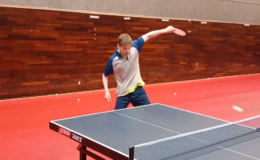By Larry Hodges, USATT Hall of Famer and National Coach
There are a number of ways to effectively force an opponent out of position. You can do this by either moving him side to side or in and out or some combination of this. In practical terms, here are ways to do so.
Corners – You play one ball wide to either the forehand or backhand. As the opponent moves wide to return the shot, he either leaves the other wide corner open, or he moves to cover that side so quickly that he leaves the other corner open. (This is really two tactics, since you can start by going wide to either the forehand or backhand.)
Middle – You go to the opponent’s middle (playing elbow), usually aggressively so as not to set him up for an easy shot from his stronger side. If he moves to cover it with his forehand, he leaves his forehand side open, and if he moves to cover it with his backhand, he leaves his backhand side open. You either play to the open side, or if the opponent moves to cover that side too quickly, you go the other way.
Short to forehand, deep to backhand – You serve or drop a ball short to the forehand, bringing the opponent in over the table. Then he’s jammed over the table and vulnerable to a deep ball to the backhand. Sometimes the opponent moves so quickly to cover the wide backhand that he’s vulnerable to another short ball to the forehand, or to deep to the wide forehand.
Short to backhand, deep to forehand – You serve or drop a ball short to the backhand, bringing the opponent in over the table. Then he’s jammed over the table and vulnerable to a deep ball to the forehand. Sometimes the opponent moves so quickly to cover the wide forehand that he’s vulnerable to another short ball to the backhand, or to deep to the wide backhand.
Deep to backhand against a forehand player – Against a forehand-oriented player, you play the ball deep to the backhand over and over, often by pushing, until the opponent steps around to attack with his forehand. You quick-block the ball to his wide forehand, or if he moves too quickly to cover that, come right back at his backhand again.
In the scenarios given above, I’ve given two places to place the ball after forcing the opponent out of position. In each case there is a third option – if the opponent is hustling to cover the corners, you can go after his middle. It’s hard to cover the middle when you are moving to get back into position. (This is why it is rarely a good idea to be moving back into position when the opponent is hitting the ball. It’s better to be in a ready position but slightly out of position than in position but in motion.)
How to apply the above? Study your opponent, and focus on using your serve and receive to set up the above, as well as doing so in rallies, and turn your opponent into a puppet – and you hold the strings!



